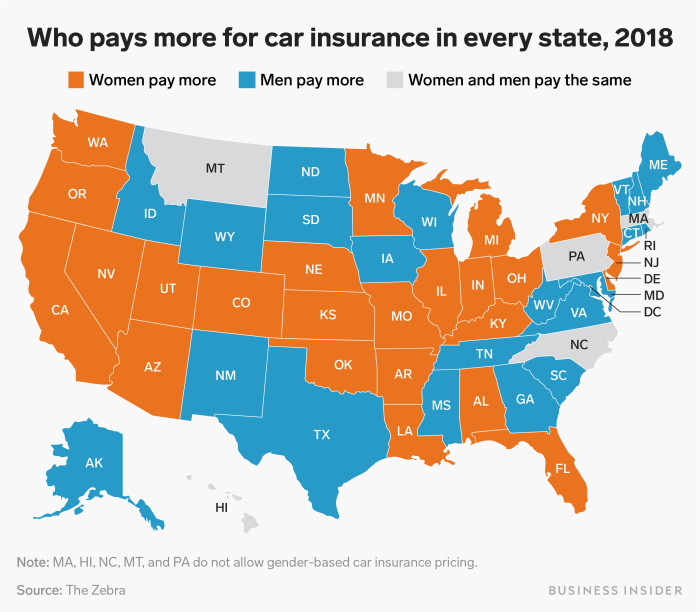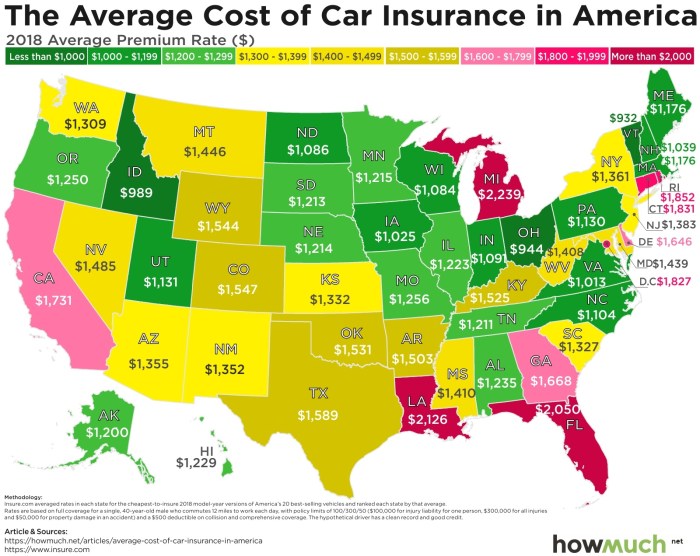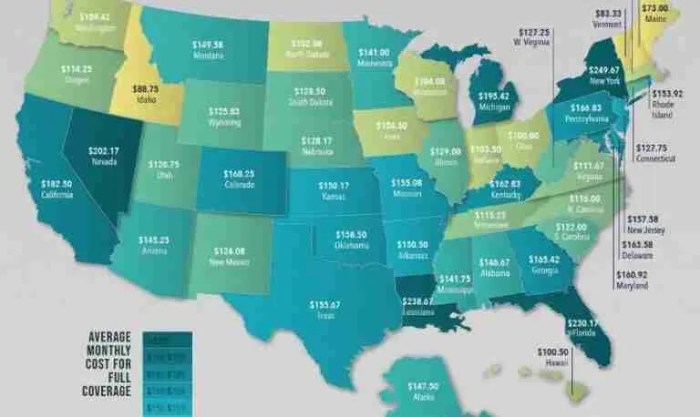Navigating the world of auto insurance can feel like driving through a maze, especially when considering the significant variations in rates across different states. Premiums aren’t simply a matter of chance; they’re influenced by a complex interplay of factors, from state-specific regulations and demographic details to the type of vehicle you drive and even your geographic location. Understanding these nuances is key to securing affordable and adequate coverage.
This guide delves into the intricacies of auto insurance rates by state, providing a clear and concise overview of the key factors that influence pricing. We’ll explore how state regulations, insurance company practices, accident statistics, and even your personal characteristics all contribute to the final cost. By the end, you’ll have a much clearer understanding of how to find the best possible auto insurance for your needs and budget.
State-Specific Insurance Regulations

State insurance regulations significantly impact auto insurance rates, creating a complex landscape of coverage requirements and liability limits across the United States. Understanding these variations is crucial for consumers to make informed decisions and compare insurance quotes effectively. These differences stem from a variety of factors, including state-specific risk profiles, legislative priorities, and the presence or absence of state-run insurance programs.
State-Mandated Insurance Coverages
State-mandated minimum coverage requirements vary considerably. Some states require only liability coverage, protecting drivers against claims for injuries or damages they cause to others. Others mandate additional coverage such as personal injury protection (PIP), which covers medical expenses and lost wages for the insured and passengers regardless of fault, and uninsured/underinsured motorist (UM/UIM) coverage, protecting against drivers without adequate insurance. For example, New York has relatively high minimum liability limits, while states like New Hampshire have no mandatory liability insurance at all, relying instead on a system of financial responsibility. These differences directly influence the base cost of insurance.
Impact of State-Specific Laws on Uninsured/Underinsured Motorist Coverage
State laws concerning UM/UIM coverage significantly influence premiums. Some states allow drivers to opt out of UM/UIM coverage entirely, leading to lower premiums but leaving drivers vulnerable in accidents with uninsured motorists. Other states mandate UM/UIM coverage, often requiring it to match or exceed liability limits. The availability and extent of UM/UIM coverage can substantially impact the cost of insurance, especially in states with high rates of uninsured drivers. For instance, a state with a large uninsured driver population and mandatory UM/UIM coverage with high limits will likely have higher average premiums compared to a state with fewer uninsured drivers and less comprehensive UM/UIM requirements.
Liability Limits Across States
Liability limits, representing the maximum amount an insurance company will pay for damages caused by an insured driver, show dramatic variation across states. Many states have minimum liability limits that are considerably low, offering minimal protection in serious accidents. Other states mandate higher limits, providing greater financial security for both the insured and victims of accidents. For example, comparing states like Pennsylvania with relatively low minimum liability limits and those like California with significantly higher limits illustrates the wide range of protection and subsequent impact on insurance costs. Higher limits generally mean higher premiums, reflecting the increased risk assumed by the insurance company.
Role of State-Run Insurance Programs
State-run insurance programs, often designed to provide coverage to high-risk drivers who cannot obtain insurance through the private market, can influence overall rates. These programs may have higher premiums than private insurers, reflecting the increased risk involved. The existence and structure of these programs can indirectly affect rates for all drivers in a state, either by increasing the overall cost pool or by stabilizing the market. The presence of a robust state-run program might reduce the pressure on private insurers to cover high-risk individuals, potentially leading to lower rates for lower-risk drivers.
Key Regulatory Differences Between High-Cost and Low-Cost States
- Minimum Liability Limits: High-cost states tend to have higher minimum liability limits, reflecting a greater level of mandated coverage and consequently higher premiums. Low-cost states may have lower minimums, leading to lower base premiums but less protection.
- UM/UIM Coverage Requirements: High-cost states often mandate UM/UIM coverage, sometimes requiring it to match liability limits. Low-cost states may allow drivers to opt out, resulting in lower premiums but increased risk for the insured.
- PIP Coverage: High-cost states frequently mandate PIP coverage, which covers medical expenses regardless of fault. Low-cost states may not require PIP, impacting the cost of insurance and the level of protection offered.
- State-Run Insurance Programs: The presence of a significant state-run insurance program, while potentially helping high-risk drivers, can indirectly influence rates across the board, potentially increasing premiums in some cases.
- Tort Reform: States with more restrictive tort laws (which limit the ability to sue for damages) often have lower insurance rates. Conversely, states with more lenient tort laws may have higher rates.
Resources for Finding Affordable Insurance

Finding the right auto insurance at the best price can feel overwhelming, but with the right approach and resources, you can significantly reduce your premiums. This section Artikels key resources and strategies to help you navigate the process and secure affordable auto insurance coverage.
Comparison Websites and Tools
Numerous online comparison tools allow you to quickly obtain quotes from multiple insurers simultaneously. These websites aggregate information from various companies, saving you the time and effort of contacting each insurer individually. Popular options include websites like NerdWallet, The Zebra, and Insurify. These platforms often include filters allowing you to refine your search based on coverage levels, deductibles, and other preferences. By inputting your information once, you receive a range of quotes, facilitating a direct comparison of prices and coverage options. Remember that the quotes you receive are estimates; the final price may vary slightly based on a more detailed assessment by the individual insurance company.
Factors to Consider When Choosing an Insurer
Selecting an insurance provider involves more than just comparing prices. Several critical factors should influence your decision. Financial stability is paramount; you want to ensure the insurer can pay out claims if needed. Consider the company’s claims handling process – how quickly and efficiently do they resolve claims? Read online reviews and check independent ratings from organizations like A.M. Best to gauge customer satisfaction and the insurer’s financial strength. The level of customer service offered, including accessibility and responsiveness, is also a significant factor to consider. Finally, examine the specific coverage options offered; ensure the policy adequately protects your needs and assets.
Strategies for Lowering Auto Insurance Premiums
Several strategies can help you reduce your insurance costs. Maintaining a good driving record is crucial; accidents and traffic violations significantly impact premiums. Consider increasing your deductible; a higher deductible usually translates to lower premiums, but be sure you can comfortably afford the increased out-of-pocket expense in case of an accident. Bundling your auto insurance with other types of insurance, such as homeowners or renters insurance, can often result in discounts. Opting for a less expensive car model or one with enhanced safety features can also influence your premium. Finally, ensure your personal information is accurate on your insurance application; inaccuracies can lead to higher rates.
The Importance of Shopping Around and Negotiating Rates
Shopping around and negotiating rates are essential for securing the best possible price. Don’t settle for the first quote you receive; compare quotes from at least three to five different insurers. Once you’ve identified a preferred provider and policy, don’t hesitate to negotiate. Politely explain your situation and inquire about any potential discounts or adjustments to the premium. Highlight your good driving record, bundled insurance policies, or any safety features on your vehicle. Many insurers are willing to negotiate to retain your business.
Actionable Steps for Consumers
- Use online comparison tools to obtain quotes from multiple insurers.
- Check the insurer’s financial stability and customer reviews.
- Maintain a clean driving record and consider increasing your deductible (within your financial capabilities).
- Bundle insurance policies where possible.
- Choose a car with good safety features and lower repair costs.
- Shop around and compare quotes from at least three to five different insurers.
- Negotiate your premium with your preferred insurer.
Closing Notes

Securing the right auto insurance is a crucial financial decision, and understanding the factors that influence rates by state is paramount. While the process may seem daunting at first, armed with knowledge of state regulations, insurance company practices, and effective comparison strategies, consumers can navigate this landscape effectively. Remember to shop around, compare quotes, and don’t hesitate to negotiate for the best possible coverage at a price that suits your budget. By taking a proactive approach, you can ensure you’re adequately protected while managing your insurance costs responsibly.
FAQ
What is the average cost of auto insurance in the US?
The average cost varies significantly by state and individual factors, but national averages can range from several hundred to over a thousand dollars annually.
Can I get car insurance without a driving history?
Yes, but expect higher premiums. Insurers assess risk based on various factors, and a lack of driving history increases perceived risk.
How often can I change my car insurance provider?
You can usually switch providers whenever your policy renews, though some companies may have early termination fees.
Does my credit score affect my auto insurance rates?
In many states, yes. Insurers often use credit-based insurance scores to assess risk, with higher scores generally leading to lower premiums.
What is Uninsured/Underinsured Motorist coverage?
This coverage protects you if you’re involved in an accident with an uninsured or underinsured driver. It helps cover your medical bills and vehicle repairs.